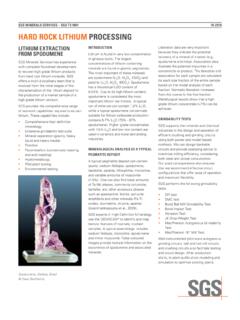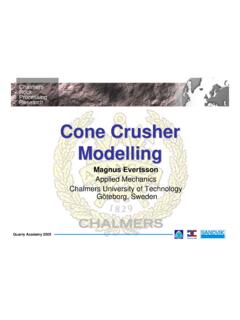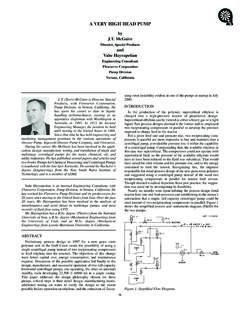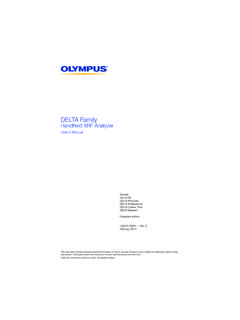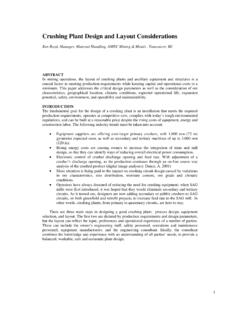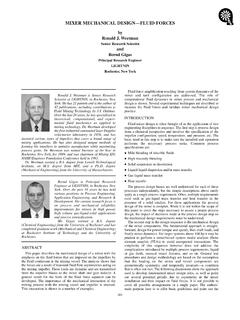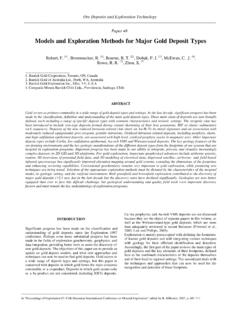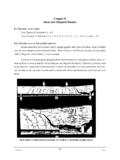Transcription of Gold Deposits and Their Geological Classification
1 In Proceedings of Exploration 97: Fourth Decennial International Conference on Mineral Exploration edited by A. G. Gubins, 1997, p. 209 220 Exploration GeochemistryGOTOA uthor IndexSection ContentsNext PaperExplor97 Master PageExplor97 ContentsPrevious PaperPa p e r 2 9 Gold Deposits and Their Geological ClassificationRobert, F.[1], Poulsen, [1], and Dub , B.[2] Survey of Canada, Ottawa, Ontario, Survey of Canada, Ste-Foy, Qu bec, CanadaABSTRACTC lassifications of ore Deposits provide essential frameworks for designing exploration strategies, evaluating prospects, andperforming resource assessments of selected areas. A rational Geological Classification of the commonly recognized lode golddeposits is feasible if it is based on the Geological settings of the Deposits , host rocks, nature of mineralization and geochem-ical signature. Sixteen common types of bedrock gold Deposits are distinguished from one another and Their main geologicalattributes are summarized.
2 Many of these deposit types represent different components of larger hydrothermal systemsactive at the same crustal levels and are genetically related. The geochemical parameters for most of deposit types are theresults of the interaction of the hydrothermal systems with particular wallrock packages. On this basis unique geochemicalsignatures are diagnostic of deposit types only for fluid-dominated systems but are less reliable indicators of deposit typesfor rock-dominated of gold Deposits is much more than a textbook exercise: itprovides an essential framework for resource assessment studies, fordesigning exploration strategies ( , what type of deposit to look for,where and how), and for evaluating prospects. Large amounts of newinformation, generated in the last 15 years in response to a renewedfocus on gold mining, reinforces the fact that there is a wide diversity ingold deposit types.
3 There is a need to summarize such information and,more importantly, to attempt to synthesize it into a coherent classifica-tion of gold Deposits . The purpose of this paper therefore is to present asummary of the Geological attributes of commonly recognized types ofbedrock gold Deposits and to present a workable Geological classifica-tion, highlighting the role of geochemistry in determining each of thedeposit development of a simple Classification scheme for gold Deposits ,as presented here, has been approached with a full appreciation thatthere are many difficulties associated with Classification of ore depositsin general. In the case of lode gold Deposits , contrasting classificationsand nomenclatures have been arrived at historically depending onwhether they were approached from genetic, geochemical, economic ortectonic points of view (Emmons, 1937; Boyle, 1979; Cox and Singer,1986; Bache, 1987).
4 In addition, several Classification schemes have beendeveloped for subsets of gold Deposits such as those considered to beepithermal (Heald et al., 1987), intrusion-related (Sillitoe, 1991), bulk-mineable (Bonham, 1989) or epigenetic Archean (Gebre-Mariam et al.,1995). These have provided additional points of view and expanded thenomenclature surrounding the problem of gold deposit Classification of lode gold Deposits is further complicatedby the following factors:1. A significant number of large Deposits are the results of superposi-tion of two or more systems, or of superposition of distinct com-ponents of hydrothermal systems due to telescoping (Sillitoe,1994): this can lead to apparently hybrid deposit Different Geological environments are also commonly superim-posed upon one another. For example, continental arcs commonlyare found superimposed on miogeoclines of mainly sedimentaryorigin or older accreted arcs of mainly volcanic origin, making itdifficult to determine which Geological features are directly relatedto Deposits and which are Geological attributes used to discriminate among deposit typesshould also be as diagnostic as possible to allow adequate classifi-cation of Deposits that have been deformed and metamorphosed indistinction to Deposits that simply occur in deformed and meta-morphosed rocks.
5 This is a particularly acute problem for depositsin Precambrian above caveats notwithstanding, the Classification scheme pro-posed here is first and foremost Geological in scope. It is based mainly,but not exclusively, on the nature and mesoscopic attributes of the min-eralization and on the Geological settings of the Deposits , in large partfollowing the approaches of other workers. Genetic connotations aresecondary and many of the different Deposits types described here mayhave formed by similar processes operating in different settings. In addi-tion, many Deposits are appear to be hybrid in that they possess, to dif-ferent degrees, characteristics of more than one deposit the proposed Classification scheme should not be viewed210 Exploration GeochemistryTa b l e 1 :Commonly recognized types of lode gold Deposits and Their main Geological TypeType ExampleSelected ExamplesWorld; CanadianGeological SettingForm of Mineralization1 PaleoplacerWitwatersrand (S.)
6 Africa)Tarkwa (Ghana), Jacobina (Brazil);rare: Huronian (ON), Sakami (QC)Mature fluviatile to deltaic facies rocks in extensive cratonic sedimentary basinsPyrite-bearing quartz-pebble conglomerate and quartz arenite2 Submarine gold-richmassive sulphideBoliden (Sweden)Mt. Lyell & Mt. Morgan (Australia),Horne, Bousquet, Agnico-Eagle (QC), Eskay Creek (BC)Mixed volcanic, volcaniclastic and sedimentary sequences in greenstone beltsBanded and stratiform massive sulphide lenses and adjacent stockwork zones3 Hot spr ingMcLaughlin (California)Hasbrouk Mountain, Buckskin Moun-tain (Nevada), Cherry Hill, Champagne Pool (New Zealand); Cinola (BC)Subaerial mafic and felsic volcanic centers and associated epiclastic rocks in volcano-plutonic beltsDisseminated sulphides in silicified and brecciated rocks; underlying quartz veins4 Adularia-sericite epithermalCreede (Colorado)Hishikari (Japan), Cavnic (Romania), Round Mountain (Nevada).
7 Lawyers, Blackdome, Cinola (BC), Skukum (YT)Subaerial intermediate to felsic volcanic centers and associated subvolcanic intru-sions in volcano-plutonic beltsCrustiform-colloform to brecciated quartz-carbonate-adularia veins5 Alunite-kaolinite epithermalGoldfield (Nevada)El Indio (Chile), Pueblo Viejo (Domini-can Republic), Nansatsu (Japan); Hope Brook (NF), Equity Silver (BC)Subaerial intermediate to felsic volcanic centers and associated subvolcanic intru-sions in volcano-plutonic beltsDisseminated sulphide in vuggy silica zones, veins, breccias and stockworks6 Porphyry goldLepanto Far South East (Philippines), Lobo (Chile)Refugio (Chile), Yu-Erya (China), Fort Knox (Alaska); Dublin Gulch (YT), Young-Davidson (ON), Douay, Troilus (QC)Calc-alkalic to alkalic, subaerial intermediate volcanic centers and associated subvolcanic intrusions in volcano-plutonic beltsIntrusion-hosted (in part) quartz-pyrite stockwork zones7 Breccia pipeKidston (Australia)Montana Tunnels (Montana), Cripple Creek (Colorado); Sunbeam Kirkland (MB), Chadbourne (QC)Mafic to felsic volcanic centers and associated subvolcanic intrusions in volcano-plutonic beltsMineralized discordant breccia bodies8 SkarnFortitude (Nevada)Red Dome (Australia), Suan (Korea); Hedley & Tillicum (BC), Marn (YT),Akasaba (QC)Carbonate platform sequences over-printed by volcano-plutonic arcsDisseminated to massive sulphide lenses and veins cutting skarn9 Carbonate replacement (manto)Ruby Hill (Nevada)Mammoth (Utah).
8 Mosquito Creek-Island Mountain (BC), Ketza River (YT)Carbonate platform sequences over-printed by volcano-plutonic arcsConcordant to discordant massive sulphide bodies in carbonate rocks10 Sediment-hosted micron gold (Carlin-type)Carlin (Nevada)Mercur (Utah), Golden Reward (South Dakota), Guizhou (China); possibly Golden Bear (BC), Brewery Creek (YT)Carbonate and impure carbonate-argillite facies of continental shelves overprinted by volcano-plutonic arcs Disseminated sulphides in discordant breccia bodies and strata-bound zones11 Non-carbonate stockwork-disseminatedPorgera (Papua New Guinea)Andacollo (Chile), Muruntau (Uzbekistan); East Malartic, Beattie (QC), Hemlo(?), Holt-McDermott (ON), QR (BC)Siliciclastic, turbiditic and volcaniclastic facies in common association with felsic to intermediate stocks and dykesStockwork, sheeted vein and disseminated strata-bound to discordant zones12Au-Cu sulphide-rich veinRossland (British Columbia)Tennant Creek (Australia); Red Mountain (BC), Mouska, Cooke, Copper Rand, Doyon #3 zone (QC)High-level intrusions and associated dykes in volcano-plutonic arcs and greenstone beltsQuartz-sulphide veins (>20% sulphide)13 Batholith-associated quartz vein(Korean type)Chenoan (Korea)Linglong (China), Charters Towers (Australia); Zeballos, Surf Inlet (BC), Ve n u s ( Y T )Tectonic uplifts containing metamorphic basement rocks and abundant granitoid batholithsQuartz veins in brittle to brittle-ductile faults14 Greenstone-hosted quartz-carbonate veinMother Lode-Grass Valley (California)Mt.
9 Charlotte, Norseman, Victory (Australia); Giant (NWT), Contact Lake (SK), San Antonio (MB), Dome, Kerr Addison (ON), Sigma-Lamaque (QC)Greenstone belts; spatially associated with major fault zonesQuartz-carbonate veins associ-ated with brittle-ductile shear zones 15 Turbidite-hosted quartz-carbonate vein (Bendigo type)Victoria Goldfields (Australia)Ashanti (Ghana), Otago (New Zealand); Camlaren (NWT), Little Long Lac (ON), Meguma (NS), Cape Ray (NF)Deformed turbidite sequencesQuartz-carbonate veins in folds and brittle-ductile shear zones16 Iron-formation-hosted vein and disseminated(Homestake type)Homestake (S. Dakota)Jardine (Montana), Cuiaba (Brazil), Hill 50 (Australia); Lupin (NWT), Farley (MB), Central Patricia and Cockshutt (ON)Mixed volcanic, volcaniclastic and sedimentary sequences in greenstone beltsBanded strata-bound dissemi-nated to massive sulphide lenses and discordant quartz veinsRobert, F., Poulsen, , and Dub , Deposits AND Their Geological CLASSIFICATION211Ta b l e 1 :Commonly recognized types of lode gold Deposits and Their main Geological attributes (cont d.)
10 Deposit TypeAssociated AlterationMetal Association Size & Grade of DepositsSelected References1 PaleoplacerOverprinting sericitization and silicificationAu> Ag; U common;Au:Ag typically 10:11-100 Mt of ore @ 1-10 g/t Au; some up to 1000 t AuMinter (1991)2 Submarine gold-richmassive sulphideSericitization and silicification; com-mon aluminous acid alteration Ag, Au, Cu, base metals;typically Ag>Au1-10 Mt of ore @ 3-10 g/t Au and 1-5% base metals Poulsen and Hannington (1996)3 Hot springSilicification, argillic and advanced argillic alteration; adulariaAu, Ag, Hg,As, Sb, Tl, Ba; locally W; typically Ag>Au; strong vertical zoningTypically <30 t Au; up to 20 Mt of ore @ 5 g/t AuNelson (1988);Bonham (1989);Berger (1985)4 Adularia-sericite epithermalSericite-Illite/Sericite- adularia; silici-fication; outward propylitic alterationAu, Ag, As, Sb, Hg Pb, Zn, Te; Au:Ag = 1:10 to 1:25;vertical zoning <100 t Au but some >500 t Au; grades of 2-70 g/t Au Heald et al.
